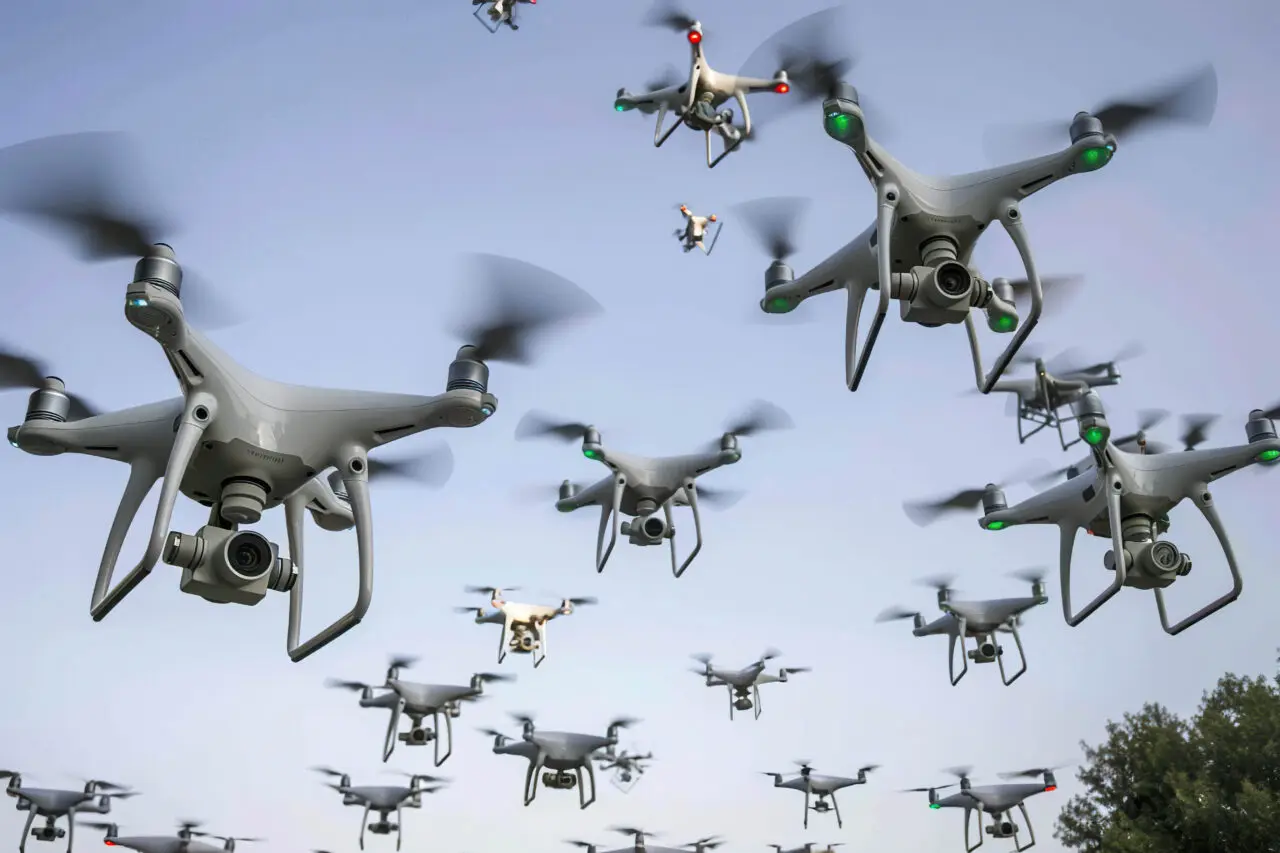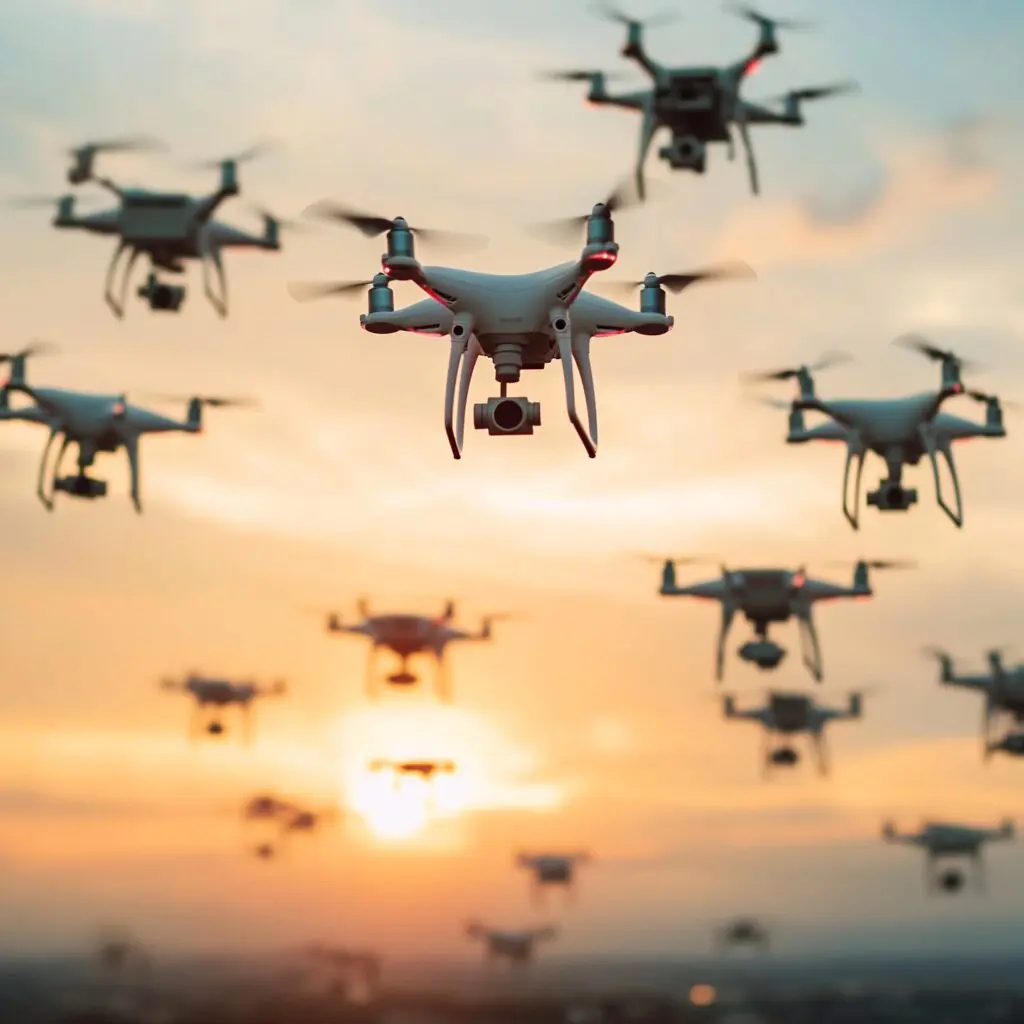

The future of drones in the military is being redefined by the integration of AI-powered drone swarms, which are set to transform drone warfare through enhanced operational efficiency and adaptability. These unmanned aerial vehicles (UAVs) can autonomously navigate complex battlefields, execute coordinated attacks, and dynamically respond to emerging threats, alleviating the burden on human operators. By collaborating as a cohesive unit and learning from each other, these intelligent armed drones can carry out intricate missions with unparalleled precision and versatility. Artificial intelligence plays a crucial role, as AI algorithms enable drones to leverage rapid data collection and analysis, improving real-time decision-making. Beyond immediate combat advantages, AI-driven drones also offer strategic benefits in electronic warfare, reconnaissance, surveillance, and logistical support, reshaping the tactical landscape and establishing new standards in military capability.
AI-powered drones are transforming drone operations across various sectors, including military and commercial applications. In military tactics, military drones equipped with advanced AI drone technology are increasingly utilised for effective drone strikes and enhancing combat capabilities. These unmanned aerial systems leverage computer vision and object detection to rapidly assess disaster scenarios, providing crucial information to first responders and facilitating efficient resource deployment. Their autonomous decision-making capabilities enable them to navigate hazardous environments and prioritise urgent tasks, potentially saving lives in critical situations. Meanwhile, drone pilots are adapting to the evolving landscape of the drone program, implementing anti-drone systems to counter emerging threats. In industries such as agriculture, logistics, and infrastructure inspection, the versatility of commercial drones is broadening their applicability. From monitoring crop health to conducting aerial deliveries and performing maintenance checks, these AI-driven unmanned aerial systems are revolutionising operations. As drone technology advances, it promises to enhance productivity, improve safety standards, and drive innovation, reshaping how industries operate and respond to challenges.
Quantum Systems’ cutting-edge drone technology is ushering in a new era in military operations, fundamentally changing how armed forces approach battlefield strategy and execution. By leveraging artificial intelligence and surveillance drones, military units can perform complex tasks with unprecedented efficiency and coordination. These unmanned aerial vehicles can undertake reconnaissance, execute precision strikes, and provide logistical support while adapting to changing conditions in real time. The technology enhances drone operation through seamless communication between military drones, allowing them to function as a unified force that learns and evolves from shared experiences. This advancement streamlines operations and reduces the risk to human life, offering a safer, more strategic approach to modern military engagements. As these AI-integrated systems continue to evolve, they promise to set new standards in military capabilities, transforming concepts of warfare and national defence, a topic of discussion at the World Economic Forum.
AI-enhanced drones are revolutionising drone flights by enabling autonomous decision-making, fundamentally changing their use across various fields. With advancements in AI drone technology, these autonomous drones can make real-time decisions, navigate complex terrains, and adapt to unexpected changes with minimal human input. This innovation greatly enhances operational flexibility and efficiency, especially in high-stakes scenarios like military operations, search and rescue operations, and critical infrastructure inspections. The ability of multiple drones to self-optimise and work together through swarm intelligence allows for coordinated missions executed with precision and speed. As a result, autonomous decision-making not only boosts the effectiveness of drone deployments but also opens new avenues for innovative applications, leveraging visual data to enhance national security and optimise commercial activities.
The rapidly growing field of AI-integrated drone technology thrives on the collaboration between AI developers and various industries, paving the way for unprecedented innovation and application efficiency. This synergy is particularly evident in sectors like agriculture, logistics, defence, and disaster management, where AI developers work alongside industry experts to enhance drone operations and tailor drone applications to specific needs. By leveraging neural networks, cutting-edge machine learning algorithms, and advanced sensor technologies, these partnerships create versatile drone solutions with autonomous capabilities that effectively address unique challenges. For example, in agriculture, drones equipped with AI can analyze crop health and improve yield predictions, while logistics companies benefit from drone deliveries and efficient route planning. Additionally, implementing robust cybersecurity measures ensures the safety and reliability of these systems. Through ongoing collaboration, AI developers and industries are not only reshaping existing paradigms but also laying the groundwork for future advancements that promise to redefine technological and operational standards across diverse domains.
AI-powered drones are revolutionising crucial industries like agriculture, logistics, and defence through advanced drone technology and artificial intelligence. In agriculture, these intelligent solutions enhance traditional farming practices with precise crop monitoring and health analysis, optimising yield and resource use. In logistics, AI drone technology boosts operational efficiency via aerial deliveries and route optimisation, significantly cutting time and costs. The defence sector benefits from autonomous capability, utilising AI drones for gathering intelligence, reconnaissance, and strategic operations, ensuring mission effectiveness while minimising risks to personnel. With capabilities in object detection and the ability to handle critical data, these innovations drive productivity and security improvements across these essential sectors.
In the rapidly advancing realm of drone technology, artificial intelligence and machine learning algorithms are essential pillars that enable drones to operate with heightened intelligence and precision. AI drone technology combines sensor fusion and computer vision, integrating data from sources like cameras, LiDAR, GPS, and thermal imaging. This allows drones to create comprehensive situational awareness, crucial for complex tasks in agriculture, logistics, and defence, as well as environmental monitoring. Coupled with AI-powered capabilities, drones can make data-driven decisions and adapt to different environments in real time. This combination empowers drones to execute sophisticated functions such as detecting anomalies, optimising flight paths, and dynamically adjusting to shifting atmospheric conditions. By leveraging these advanced technologies, drones not only enhance their operational capabilities but also unlock new potential applications, revolutionising industries by improving efficiency, accuracy, and responsiveness in an evolving technological landscape.
AI-powered drone swarms are revolutionising surveillance and search and rescue missions, representing a significant advancement over traditional methods. By leveraging collective intelligence, these autonomous drones operate with remarkable efficiency and adaptability, allowing for rapid deployment across diverse terrains. Sophisticated machine learning algorithms and neural networks empower each drone within the swarm to process real-time video data, ensuring precise navigation and decision-making. This enables the drones to coordinate their efforts autonomously, forming a cohesive and dynamic force capable of simultaneous operations. In surveillance, AI-enhanced drones offer persistent monitoring with minimal human oversight, delivering crucial intelligence for tactical decisions. During search and rescue missions, the swarms’ ability to divide and conquer enables quick location and assessment of affected areas, greatly increasing the likelihood of successful outcomes. As these AI-powered drones continue to evolve, their use in surveillance and rescue operations promises enhanced safety, efficiency, and effectiveness, redefining the standards of modern mission strategies.
AI-driven drones are poised to redefine national security and crisis management landscapes, offering revolutionary capabilities beyond conventional battlefield applications. By leveraging real-time data analysis and decision-making capabilities, these advanced drones provide enhanced situational awareness, crucial for proactive threat detection and response. Their ability to operate autonomously in high-risk environments reduces human exposure to danger while also ensuring rapid and precise execution of strategic initiatives. In crisis management scenarios, AI drones can conduct swift surveys of disaster-stricken areas, facilitate communication restoration, and expedite aid delivery, significantly improving the efficiency of relief operations. As the integration of AI in drone technology continues to advance, it promises a future where security and crisis management are fortified through intelligent, responsive, and adaptable aerial solutions.

This website uses cookies to improve your experience. Choose what you're happy with.
Required for the site to function and can't be switched off.
Help us improve the website. Turn on if you agree.
Used for ads and personalisation. Turn on if you agree.
This website uses cookies to improve your experience. Choose what you're happy with.
Required for the site to function and can't be switched off.
Help us improve the website. Turn on if you agree.
Used for ads and personalisation. Turn on if you agree.